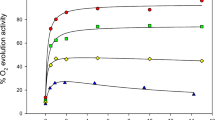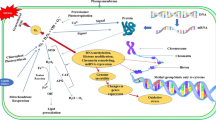Abstract
Addition of ATP to intact symbiosomes isolated from soybean nodules, resulted in generation of a membrane potential (positive inside) across the peribacteroid membrane (PBM). This energisation was monitored as oxonol fluorescence quenching. The rate of fluorescence quenching was inhibited by the inclusion of permeant anions in the reaction medium. Using this inhibition as a measure of anion uptake across the PBM, the presence of a phthalonate-sensitive dicarboxylate carrier on the PBM was confirmed. Following dissipation of the membrane potential by a permeant anion, a pH gradient, measured using [14C]methylamine uptake, was slowly established across the PBM. This ΔpH was abolished by addition of an uncoupler but was insensitive to inhibitors of bacteroid respiration. The difference in pH between the external medium and the symbiosome interior was estimated to be in the range of 1–1.6 pH units. The magnitude in planta will depend on the concentrations of ATP and permeant anions in the cytosol of the host cell.
Similar content being viewed by others
Abbreviations
- PBM:
-
peribacteroid membrane
- Δψ:
-
electrical membrane potential
- MA:
-
methylamine
References
Bassarab S, Mellor RB, Werner D (1986) Evidence for two types of Mg++-ATPase in the peribacteroid membrane from Glycine max root nodules. Endocyt Cell Res 3:189–196
Blumwald E, Fortin MG, Rea PA, Verma DPS, Poole RJ (1985) Presence of hostplasmamembrane type H+-ATPase in the membrane envelope enclosing the bacteroids in soybean root nodules. Plant Physiol 78:655–672
Day DA, Price GD, Udvardi MK (1989) The membrane interface of the Bradyrhizobium japonicum-Glycine max symbiosis: peribacteroid units from soybean nodules. Aust J Plant Physiol 16:69–84
Delves AC, Matthews A, Day DA, Carter AS, Carroll BJ, Gresshoff PM (1986) Regulation of the soybean-Rhizobium nodule symbiosis by shoot and root factors. Plant Physiol 82:588–590
Dilworth M, Glenn A (1984) How does a legume nodule work? Trends Biochem Sci 9:519–522
Domigan NM, Farnden KJF, Robertson JG, Monk BC (1988) Characterization of the peribacteroid membrane ATPase of lupin root nodules. Arch Biochem Biophys 264:564–573
Herrada G, Puppo A, Rigaud J (1989) Uptake of metabolites by bacteroid-containing vesicles and by free bacteroids from french bean nodules. J Gen Microbiol 135:3165–3171
McKay IA, Dilworth MJ, Glenn AR (1988) C4-dicarboxylate metabolism in free-living and bacteroid forms of Rhizobium leguminosarum MNF3481. J Gen Microbiol 134:1433–1440
Ou Yang L-J, Udvardi MK, Day DA (1990) Specificity and regulation of the dicarboxylate carrier on the peribacteroid membrane of soybean nodules. Planta 182:437–444
Palmieri F, Klingenberg M (1979) Direct method for measuring metabolite transport and distribution in mitochondria. Methods Enzymol 56:279–301
Peterson GL (1977) A simplification of the protein assay method of Lowry et al. which is more generally applicable. Anal Biochem 83:346–356
Price GD, Day DA, Gresshoff PM (1987) Rapid isolation of intact peribacteroid envelopes from soybean nodules and demonstration of selective permeability to metabolites. J Plant Physiol 130:157–164
Robertson JG, Warburton MP, Lyttleton P, Fordyce AM, Bullivant S (1978) Membranes in lupin root nodules II. Preparation and properties of peribacteroid membranes and bacteroid envelope inner membranes from developing lupin nodules. J Cell Sci 30:151–174
Saroso S, Dilworth MJ, Glenn AR (1986) The use of activities of carbon catabolic enzymes as a probe for the carbon nutrition of snake bean bacteroids. J Gen Microbiol 132:243–249
Scherman D, Henry JP (1980) Oxonal V as a probe of chroaffin granule membrane potentials. Biochim Biophys Acta 599:150–156
Udvardi MK, Day DA (1989) Electrogenic ATPase activity on the peribacteroid membrane of soybean (Glycine max L.) root nodules. Plant Physiol 90:982–987
Udvardi MK, Day DA (1990) Ammonia (14C-methylamine) transport across the bacteroid and peribacteroid membranes of soybean root nodules. Plant Physiol 94:71–76
Udvardi MK, Price GD, Gresshoff PM, Day DA (1988a) A dicarboxylate transporter on the peribacteroid membrane of soybean nodules. FESB Lett 231:36–40
Udvardi MK, Salom CS, Day DA (1988b) Transport of l-glutamate across the bacteroid but not the peribacteroid membrane from soybean root nodules. Mol Plant Microbe Interact 1:250–254
Udvardi MK, Ou Yang L, Young S, Day DA (1990) Sugar and aminoacid transport across symbiotic membranes of soybean nodules. Mol Plant Microbe Interact 3:334–340
Verma DPS, Kazazian V, Zogbi V, Bal AK (1978) Isolation and characterization of the membrane envelope enclosing the bacteroids in soybean root nodules. J Cell Biol 78:919–936
Author information
Authors and Affiliations
Additional information
The term symbiosome refers to the peribacteroid unit consisting of bacteroids enclosed in the host-derived peribacteroid membrane
Rights and permissions
About this article
Cite this article
Udvardi, M.K., Lister, D.L. & Day, D.A. ATPase activity and anion transport across the peribacteroid membrane of isolated soybean symbiosomes. Arch. Microbiol. 156, 362–366 (1991). https://doi.org/10.1007/BF00248711
Received:
Accepted:
Issue Date:
DOI: https://doi.org/10.1007/BF00248711




